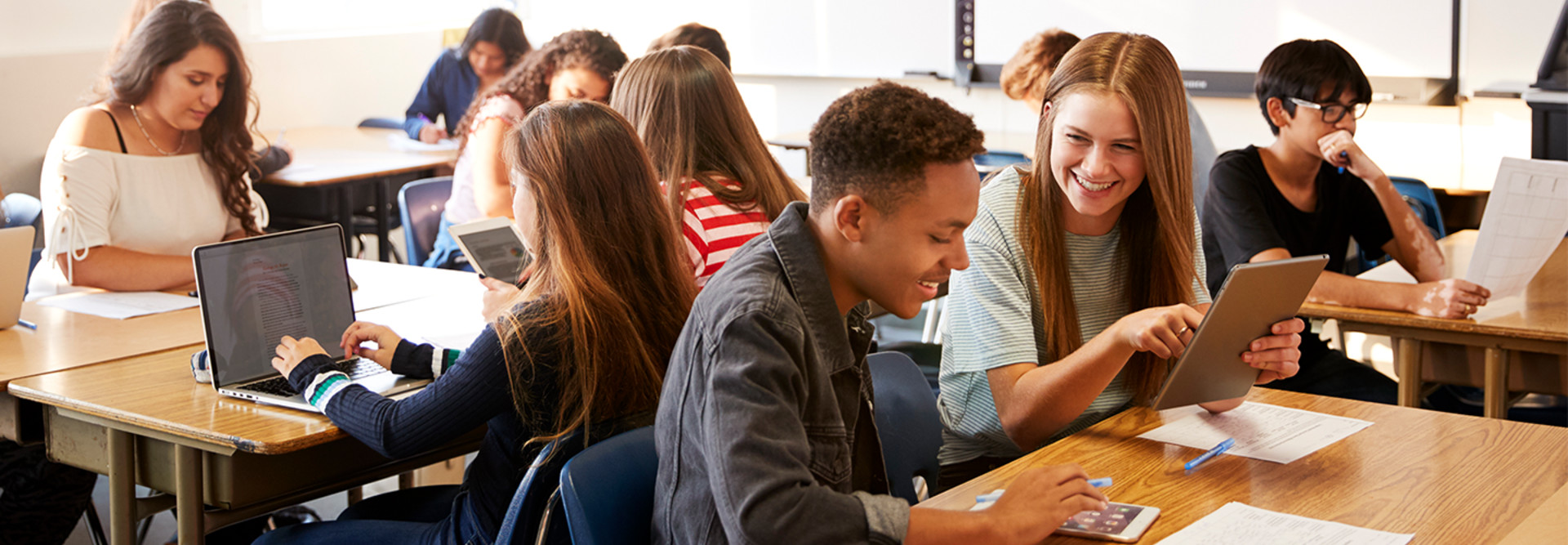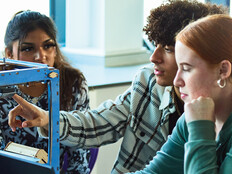Blending in Technology Boosts K–12 Instruction
Technology is an ideal vehicle for teachers to better blend classroom instruction with learning opportunities occuring outside of the traditional school day — and outside of the brick-and-mortar school building.
By bridging the gap between physical and online spaces, schools see their students improve academically and engage with their studies on a deeper level.
Blended learning “can provide educators and students with a wealth of actionable insights on student learning, needs and preferences, empowering them to deliver the right learning resources at the right time for the right students,” according to the Consortium for School Networking’s Tech Enablers 2019 report.
In California, students at Chula Vista Elementary School District’s Salt Creek Elementary improved their scores by 137 percent over the state average on California’s performance exams in the first year of introducing a blended learning program.
This trend continued into the second year, with scores improving by 172 percent compared to the state average.
There is no doubt that the marriage of online and physical classroom experiences is a boon for K–12 educators and students. The questions that remain concern which of these resources are available and how can they continue to help students.
MORE FROM EDTECH: CSee how schools use virtual reality to improve assistive learning programs.
Blended Learning Programs Improve the Learning Without the Lecture
At Eastern Senior High School in Washington, D.C., Kareem Farah, a statistics teacher, found his students and fellow teachers brightened at the chance to use a blended learning module.
Using an online platform, Farah developed a way for teachers to share instructional videos and online resources with students, throwing out the need for traditional, lecture-style teaching and replacing it with time for students to work on individual and group projects that they care about.
Farah’s program added a personal element to the school day, letting teachers connect with their individual classes through a standardized curriculum.
“School-wide initiatives can be seamlessly woven into an educator’s blended resources, allowing for content to be personal to their own school and classroom,” Farah writes in an Edutopia blog post. “And students still feel that the expert is in the room with them, allowing teachers to build trust and facilitate strong student relationships.”
MORE FROM EDTECH: How to keep accessibility in mind for the modern K–12 classroom.
3 Education Technologies Improve Blended Learning Initiatives
Myriad programs are available for teachers, such as Google Classroom and Microsoft Teams, to help craft the best learning experience for students.
On top of tools students can access from their personal devices, schools are using new types of classroom tech to expand their blended learning programs, making them even more successful.
-
Artificial Intelligence: Smart assistants can help teachers and students use time more efficiently. Acting as tutors or teaching assistants, AI makes classroom time more effective and leaves educators time to address more personal needs. AI can also help teachers collect and parse data, giving them more insight into how they should structure blended learning curriculums.
-
Virtual Reality Headsets: Immersive technology was first marketed as a way to take students to faraway lands and on trips through the past. However, educators have expanded its use to cover a wide variety of subjects, such as biology and computer science, creating lesson plans more engaging than simply reading from a textbook or tablet. Introducing VR headsets can also help shore up socioeconomic, geographical, physical and cognitive barriers. Schools without the funds for science labs can have their students mix chemicals virtually, and students with reading challenges can break down books using captivating visual elements.
-
Augmented Reality: While AR tools also use virtual elements, the greatest benefit of this tech compared to VR is that students can engage with those elements together in a collaborative space. Students can use their phones or tablets to learn about historical artifacts or solve geometry questions in groups, building on important soft skills like problem-solving and communication in an immersive way.
While students will always need to have face time with their teachers, blending traditional tools with new learning technology can vastly improve the education experience for all classroom stakeholders.
This article is part of the "Connect IT: Bridging the Gap Between Education and Technology" series. Please join the discussion on Twitter by using the #ConnectIT hashtag.
![[title]Connect IT: Bridging the Gap Between Education and Technology [title]Connect IT: Bridging the Gap Between Education and Technology](http://www.edtechmagazine.com/k12/sites/default/files/articles/2014/05/connectit.jpg)









